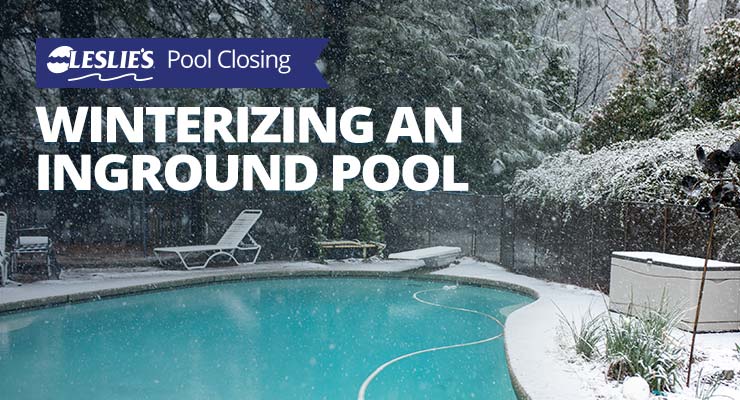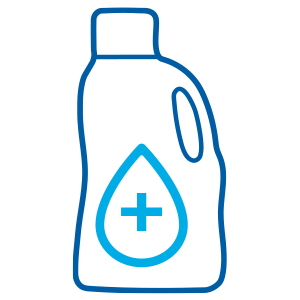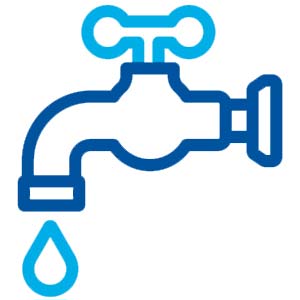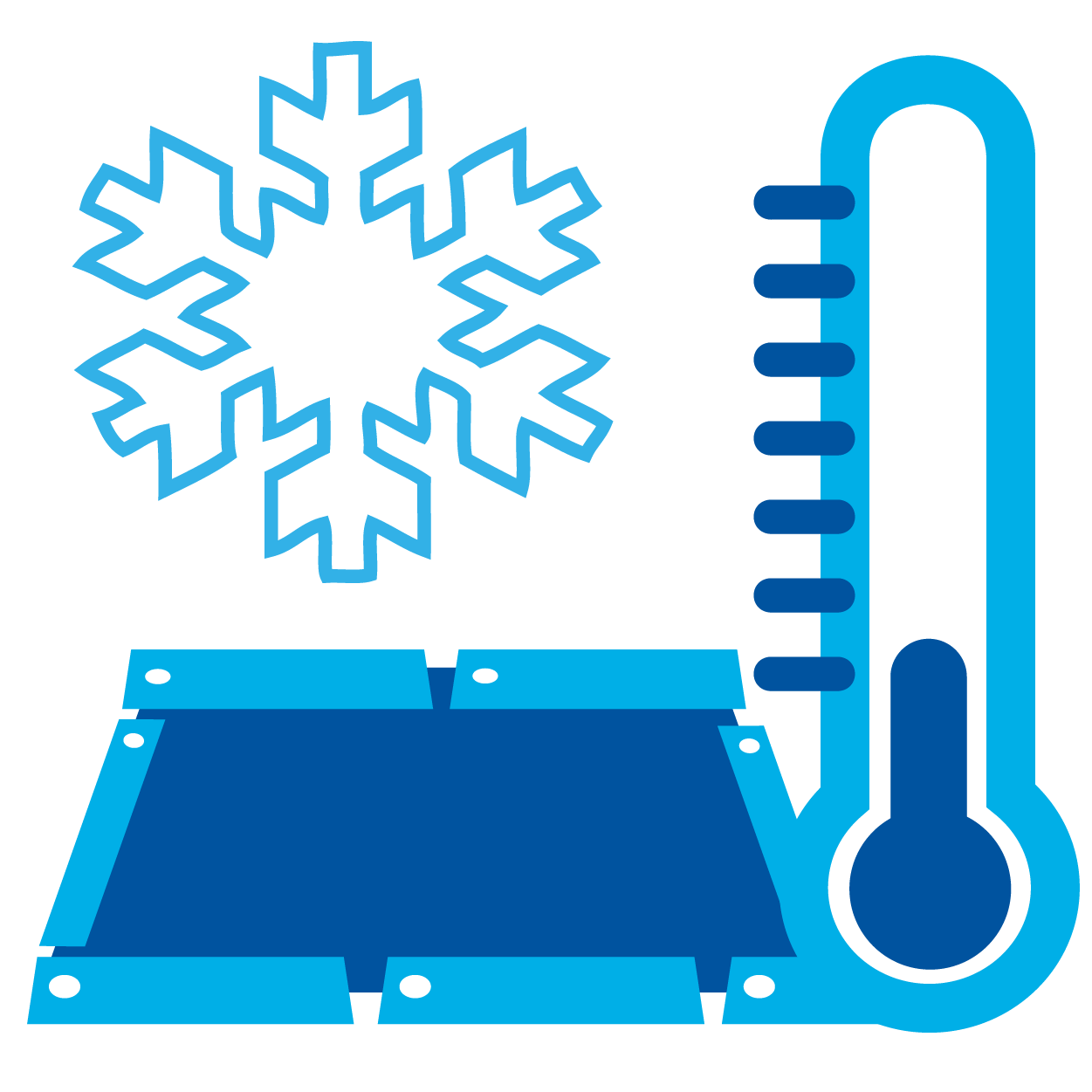
Winterizing an Inground Pool
Another fun swimming season has come and gone, and now it's time to start thinking about preparing your swimming pool for the cold off-season months. Properly winterizing your inground pool will not only protect your pool and equipment against freeze damage, it will also save you time and money when opening your pool back up in the spring.
If you've never closed a pool before, winterizing your pool may seem daunting at first. But with the right supplies, and by following all the steps we've included in the guide below, you'll find it's actually a pretty stress-free process. With Leslie's, you'll learn how to safely and effectively prepare your inground pool for the cold winter months.
Pool Closing Supplies Checklist

Let's get started! First, you'll want to make sure you have the right winterizing supplies — including tools, chemicals, and accessories — on hand. This will save you a lot of time and extra hassle on pool closing day.
- Water Balancing Chemicals
- Pool Closing Kit or Closing Chemicals
- Skimmer, Brush, and Vacuum Attachments for Telescoping Pool Pole
- Winter Cover or Safety Cover
- Leaf Net
- Blower or Wet-Dry Vac
- Blowout Extension
- Winterizing Plugs
- Skimmer Guard and/or Skimmer Plug
- Non-Toxic Pool Antifreeze
- Water Tubes or Winter Cover Blocks (for Winter Cover)
- Submersible Pump
Winterizing Inground Pools for Freezing Conditions
If you live in a climate that will see long periods of freezing temperatures, and you own an inground pool, follow these easy-to-follow instructions, or watch the video below, to help you winterize and close your pool at the end of the season.
BONUS TIP: Avoid closing the pool too early! Wait until temperatures are consistently below 65ºF before you winterize your inground pool. Closing too early can set you up for a lengthy, costly pool opening next spring. This is because warm water uses up sanitizer more quickly than cool water, which can increase the risk of algae growth.

1. Control Phosphates
One week before you close your pool, add 14 fluid ounces of Pool Magic + PHOSfree for every 10,000 gallons of water. You can add this directly to the skimmer while the pump is running. A 1-liter bottle will treat 25,000 gallons. Carefully read and follow all label instructions.
2. Thoroughly Clean the Pool
This is a crucial step in winterizing your inground pool. A dirty pool at closing time will use up sanitizer quickly, setting you up for an even dirtier pool when you remove the cover in a few months.
Start by skimming large debris from the surface and floor of the pool. Then brush all pool surfaces, corners and crevices. Finish up by vacuuming the pool thoroughly to remove all remaining dirt, leaves and debris.
3. Prevent Stains and Pool Scale
If you purchased a Pool Closing Kit, your stain and scale prevention products will be included in the package. Now is the time to add either the Stain and Scale Pill or MetalFree, depending on which is included in your chosen kit.
If you don't have a Pool Closing Kit, add MetalFree or Leslie’s Stain and Scale Remove to prevent staining and scaling through the off-season. For every 20,000 gallons of pool volume, add one liter of MetalFree or one quart (32 ounces) of Leslie's Stain and Scale Remove. Add these chemicals by pouring them around the perimeter of the pool. Again, always read and follow label instructions to ensure proper dosage and application.

4. Test and Balance Your Pool Water
The key to successfully closing and reopening a pool lies in the water balance. This one step will save you lots of time and money when you go to open your pool again next spring. Start by testing the water, paying close attention to the Total Alkalinity, pH, and Calcium Hardness levels. If they aren't in range, make adjustments as necessary.
Keep Total Alkalinity in the 80–120 ppm range, depending on the type of primary sanitizer used. It should be between 80–100 ppm for sodium hypochlorite, calcium hypochlorite, or lithium hypochlorite, and between 100–120 ppm for dichlor, trichlor, and bromine sanitizers.
Next, adjust the pH to between 7.4–7.6. Calcium Hardness should be about 200–400 ppm, which is ideal.
If you need help testing and balancing the water in your pool, take a look at our comprehensive guide, How To Balance Pool Water. Just remember, follow all label instructions, and never mix pool chemicals! Wait at least 1 or 2 hours between chemical applications. The exception to this rule is if you need to adjust Calcium Hardness levels, do not add a hardness increaser on the same day as sodium carbonate (Soda Ash) or sodium bicarbonate (Alkalinity Up).
BONUS TIP: Looking for the most accurate pool water analysis? You can have your water tested for FREE at Leslie's! Bring a water sample to your local Leslie's for a complimentary AccuBlue® test. This test precisely measures 10 different aspects of pool chemistry, and produces a customized treatment plan that's catered to your specific pool. While you're here, our knowledgeable pool experts can also answer any questions you might have about winterizing your inground pool.
5. Control Algae
Add one quart (32 ounces) of Leslie's Algae Control per 25,000 gallons of pool water. Mix it with water in a large bucket, then pour the mixture around the perimeter of the pool. With the pump running at high speed, wait one hour before moving on to the next step.

6. Add Non-Chlorine Pool Shock
With the pool pump still running, shock the pool with Leslie's Fresh 'N Clear at the rate of 1–2 pounds per 10,000 gallons. Do this by broadcasting the product around the perimeter of the pool. Wait 30 minutes.
7. Adjust Chlorine Level
If the Free Available Chlorine level isn't already between 2.0–4.0 ppm, bring the levels up by broadcasting Leslie's Chlor Brite across the deep end of the pool while the pump is running. To increase the chlorine level by 1.0 ppm, use about 3 oz. of Chlor Brite per 10,000 gallons of water.
8. Run the Pump and Clean the Filter
Let the pump run for at least one complete cycle (usually about 8 hours or longer) after you've finished adding chemicals. Once the cycle is complete, backwash or manually clean your pool filter.
9. Add WinterPill
Now is the time to add a WinterPill to the pool. These are included in Leslie's Pool Closing Kits, or can be purchased separately. Follow label instructions to puncture the Pill and set it in the water.
10. Turn Off the Pool's Power Supply
Turn off the main power supply to the pool, and remove the ON and OFF trippers from the time clock. This will prevent your pump from turning on during the next steps as you work to winterize your inground pool.

11. Lower Water Levels in the Pool
Lower the water level below the skimmer and all return lines (normally about 18 inches below the tile line). You can use a submersible pump to remove water from the pool.
Alternatively, a blowout extension may be used to remove water from the return lines in step #14. If using a blowout extension, you'll only need to drain the pool about 4–6 inches below the skimmer. Keep in mind that if you have a fiberglass or vinyl liner pool, this is all the lower you should bring the water level — draining the pool to the level of the returns can put your pool at risk for damages. Always refer to the pool builder's or manufacturer's recommendations for winterizing procedures to avoid harming your pool.
12. Drain All Pool Equipment
Remove all drain plugs from the pump strainer basket housing, the pump volute, the filter tank, and the pool heater. Keep the drain plugs handy — you'll want to store them in the pump basket so they don't get lost over the winter.
If you have an automatic chlorinator or a booster pump for your pool, follow the manufacturer's instructions to drain them, too.
13. Adjust the Filter Valve
Position the multiport valve handle between any two settings. This will ensure all ports are partially open to allow for freeze expansion. Most multiport valves have a "Winter" or "Winterize" label between two regular settings for this purpose.
14. Winterize the Pool Plumbing
When the water has completely drained out of the plumbing lines (or after you've blown out the lines), put winterizing plugs into the returns of your inground pool.
Add non-toxic pool antifreeze to all lines. This specialized antifreeze should be added at the rate of one gallon per 10 feet of pipe.
Finally, use the blowout extension or add a Skimmer Guard into the skimmer to seal the skimmer pipe. This will protect your skimmer by absorbing pressure from expanding ice. It will also cause an "air lock" in the plumbing to prevent water from rising up from the main drain.

15. Add Water Back Into the Pool
If you drained the pool below the returns, refill the pool to between 4–6 inches below the skimmer inlet or tile line. This is the correct water level for most vinyl liner, fiberglass, gunite, or plaster pools. Again, we suggest referring to the pool builder's recommendations for water levels in your winterized pool.
16. Remove All Non-Permanent Fixtures and Accessories
Remove articles as ladders, hoses, over-the-top skimmers, floats, toys, and so forth. If you have any handrails, diving boards, or pool slides that will come in contact with the pool cover, consider removing those, as well.
Don't forget to remove the automatic pool cleaner (if you haven't already), and drain it completely. Lay the hoses out straight in a non-freezing location, such as a basement or heated garage.
17. Install Air Pillows
Although not required to winterize an inground pool, air pillows can alleviate ice expansion and reduce the risk of wall and tile damage in areas that experience a hard freeze. Inflate and tie air pillows to a stationary object. An average-sized inground pool, 16’ x 32’, typically requires 2–3 air pillows. If you are using multiple pillows, tie them together using the grommets, which are located on the pillow's corners.
For plaster pools only: tie a floating chlorinator to one of the air pillows. It should be set at its lowest rate of feed.
18. Install the Winter Cover

If the coping or deck of the pool has a rough surface or edge, protect the pool cover by placing foam, old solar cover material, or other similar soft materials around the perimeter of the pool.
Cover the pool using a properly sized safety cover or winter cover. In areas with lots of trees, a leaf net can be helpful for quickly removing excess debris from the cover. Simply lay it over the top of your winter pool cover.
If using a traditional winter pool cover, fill and place water bags or winter cover blocks around the edge of the pool to secure your cover, filling them 1/2–3/4 full. In normal conditions, these can be placed 18 inches apart, but in windy areas, they should be placed end-to-end to hold the cover in place. Don't ever use things like lawn furniture or cinder blocks to hold the cover down. If they fall in the pool, you'll risk these items damaging pool surfaces.
When using a safety cover, make sure the straps, springs, and anchor hardware are all in good shape. If not, replace them with new parts.
Winterizing Inground Pools for Non-Freezing Conditions
If you live in the sunbelt, or an area where you're not likely to see winter temperatures fall below freezing, you'll still follow most of the steps above to prepare your pool for the off-season. However, when winterizing your inground pool, you'll skip steps 10–17, as they won't be necessary.

Once the pool is covered, set the pool timer to run the pump at least 2–4 hours per day. Keep a close eye on the forecast, and keep the pump running whenever there's a chance of freezing temperatures. This will keep the water flowing, which will prevent freeze damage in your pool equipment and plumbing. There are also freeze sensors available that can turn the pump on automatically when temperatures fall below a certain level.
On the other hand, you could also keep the pool open all winter. For more information on the different off-season options for warmer climates, check out our blog, Winter Care for Sunbelt Pools.
Looking for a printable checklist? Download our Winter & Off-Season Instructions for Inground Pools.
No matter the climate or how you winterize your inground pool, it's important to keep up with routine maintenance over the winter.
At least once per month, take a peek under the cover. Visually inspect the water and look for changes in color, signs of stains and scaling, or evidence of a pool leak. You'll also want to check the cover for damage, and test the water every 2–4 weeks to make sure there's still sanitizer available.
If you notice any issues with the water, or have questions related to your winterized pool, don't hesitate to call or visit your local Leslie's. We can help!